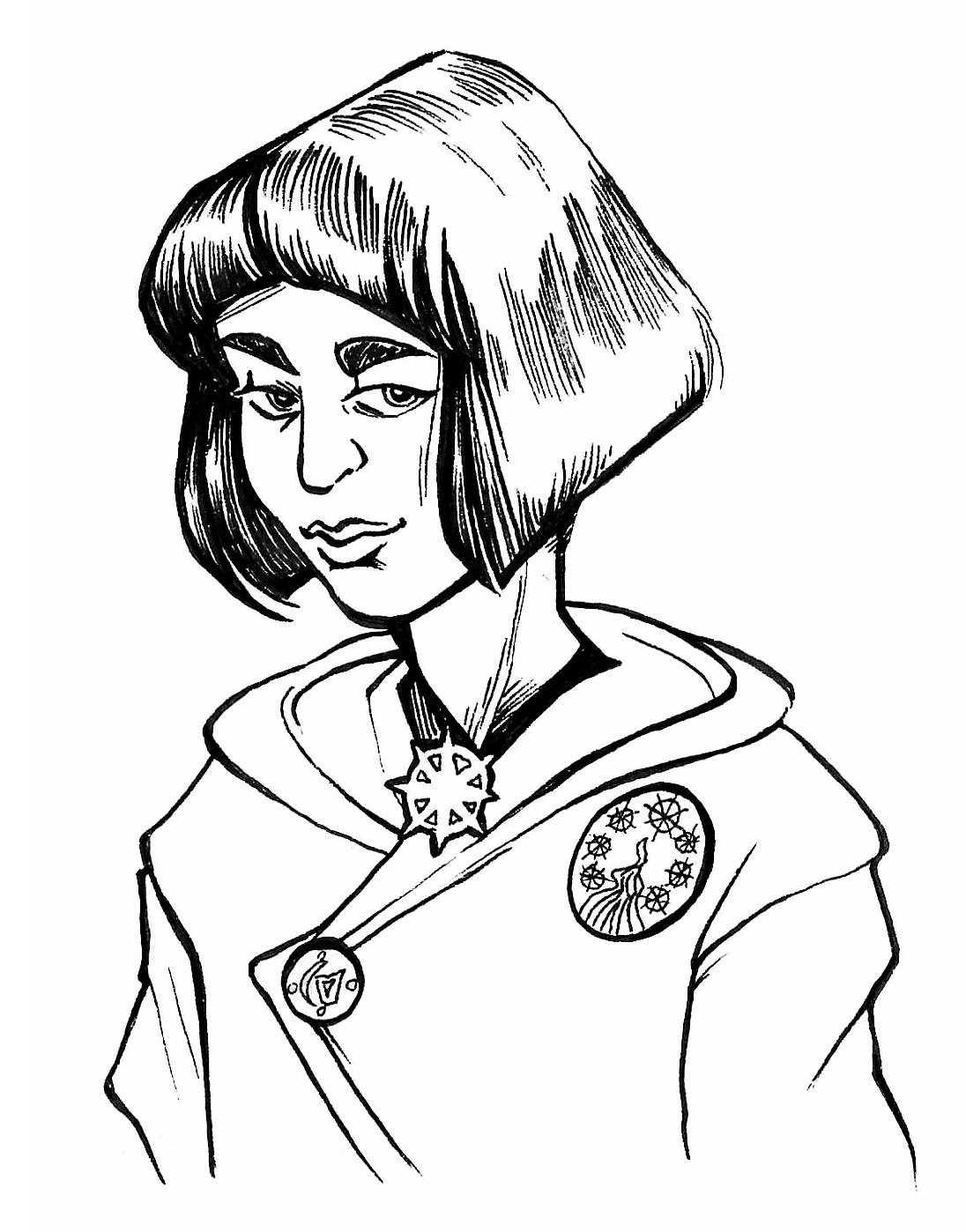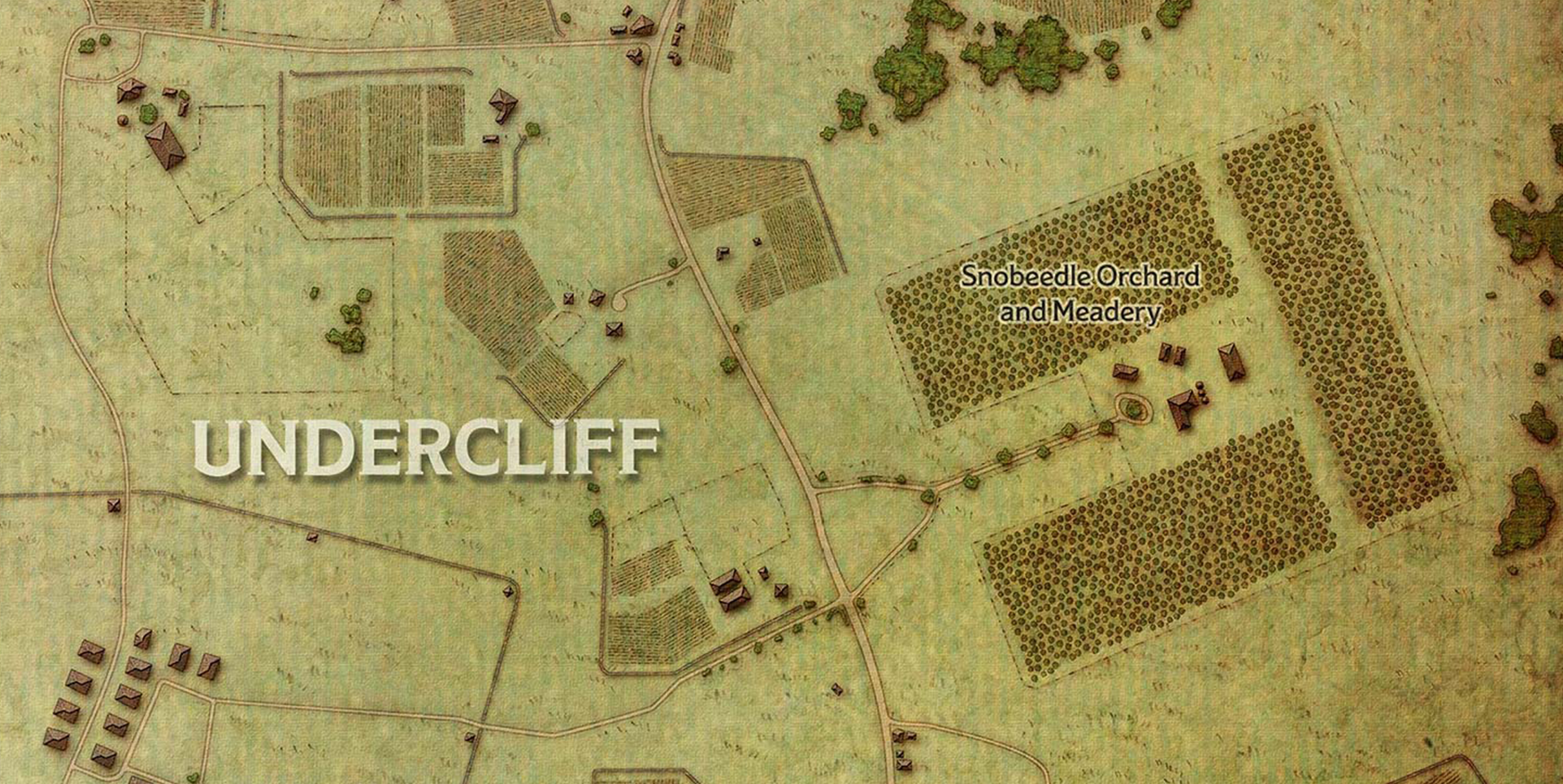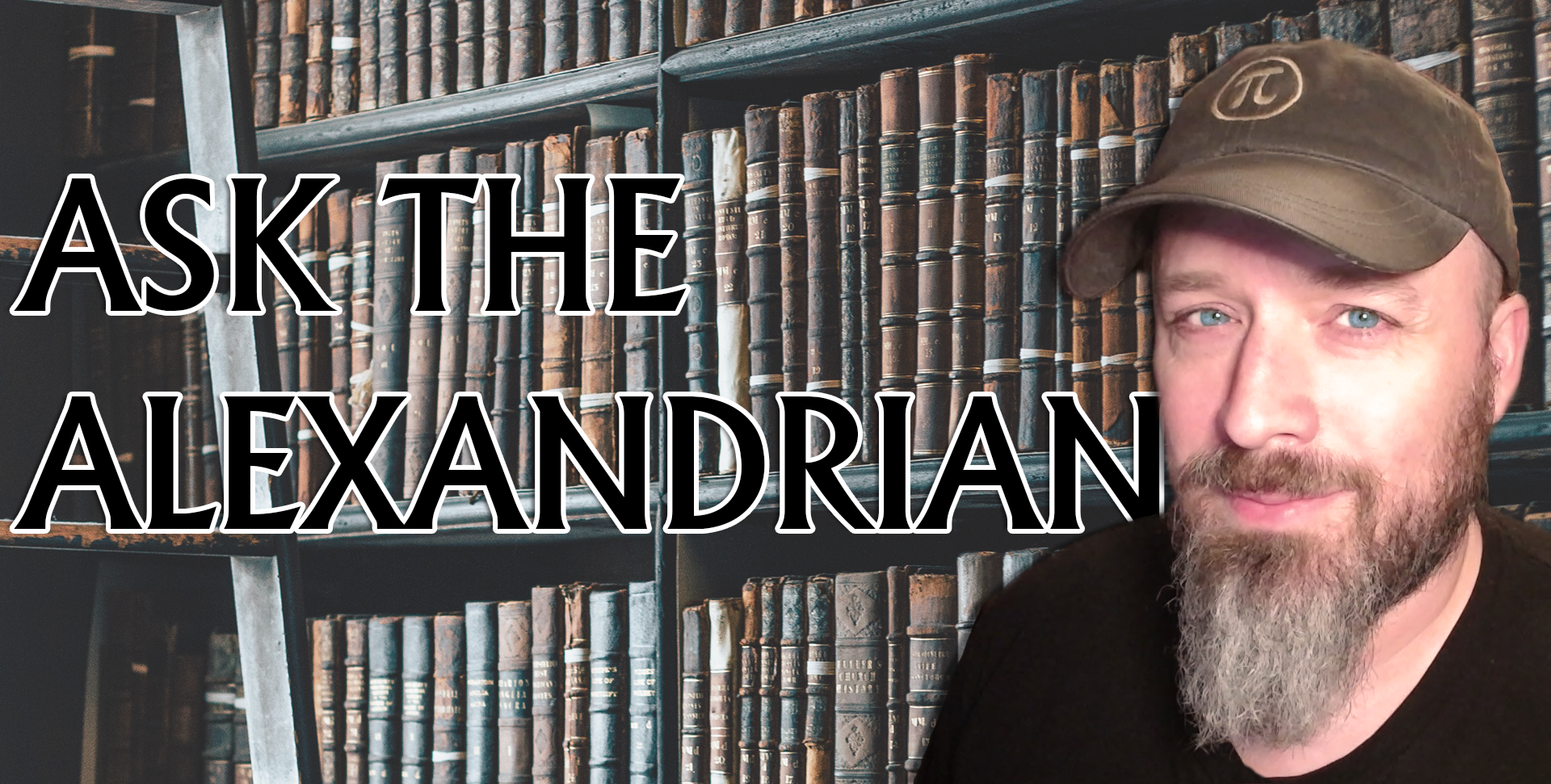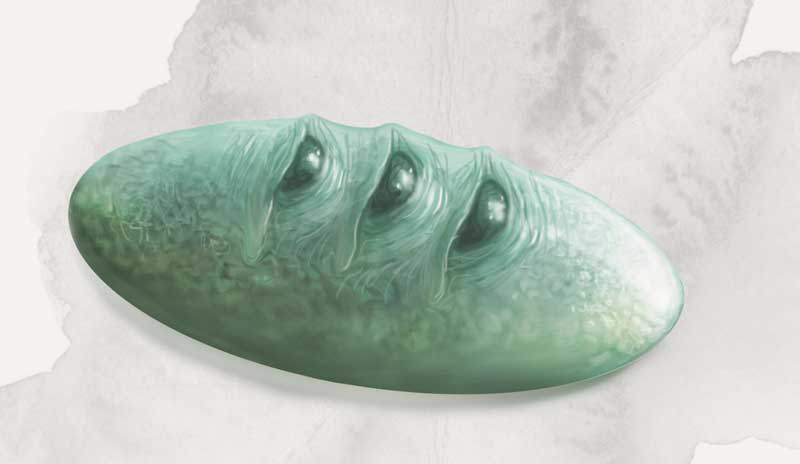Go to Part 1
KORA MARWOOD
(Created by Chris Malone)
Kora Marwood was born the youngest to an impoverished family living in Waterdeep. Her father, Hogar, was a member of the guard and occasional longshoreman, and her mother cared for her four siblings and kept house in a shabby apartment in the Dock Ward. In the autumn of 1471, Kora’s mother, Samira, took a short-term field job with the Snobeedle Orchard and Meadery. In the  midst of a work day, she unexpectedly gave birth to Kora in the middle of the field.
midst of a work day, she unexpectedly gave birth to Kora in the middle of the field.
Life continued to be difficult for the Marwoods, and things finally fell apart for the family when Hogar died while working on a job on the docks, killed by a faulty bit of cargo netting and crushed to death by lumber imports from Chult. Samira, fearing for her inability to care for Kora and her siblings, brought them to the Temples for adoption.
Kora, only three years old at the time, remembers little of her mother and her family. While her siblings went to temples of Lathander and Ilmater, Kora was taken by the acolytes of Mystra. She was raised in the mysteries and teachings of Mystra, learning the histories of civilization, magic, and religion. While life was safe and predictable, it was also boring. Kora began sneaking out at night to spend time in the city, and soon found herself enamored with a young man named Aseir Kalid, from Calimshan.
Aseir was an artist, working during the day in his father’s shop weaving and dyeing, and then working on his own projects when he had time. When he presented her with a small wooden painting of her one night, she decided that she was done with life in the temple and left shortly thereafter. She lived with him for six months, exploring the city with new eyes. It was in the Spring of 1486 that Aseir fell ill with the Weeping Plague, an illness that began with sores around the eyes and nose that wept a clear fluid, then quickly spread throughout the body, followed by a fever and, for many, death. Brought to Waterdeep from ports far away, the city respond quickly with quarantine. It was then that Kora was reunited with her brother Randal, who had become a priest of Ilmater. Despite his training and magical prowess, he was unable to save Aseir, and left Kora in quarantine to care for him until he passed.
Heartbroken, Kora returned to the temple, throwing herself at the feet of the Head Priest. She begged him to take her back, so that she could serve the temple as a lay healer. While Mystra is not inclined towards life and healing, magic serves all, and they taught her the healing arts. She took to it quickly, showing prowess and aptitude.
She was asked to accompany a pilgrimage to Myth Drannor as a healer and acolyte, and she attended to this. Along the way, she made the acquaintance of a dwarven ranger named Dain Balderk. Dain was initially standoffish with Kora, but after she had several opportunities to demonstrate her knowledge, diplomacy, and skill, he showed a grudging respect. Unfortunately, the arrival of the pilgrimage was preceded by destruction, as the city of the Netherese fell upon Myth Drannor, destroying it. Again.
The pilgrimage stayed at the Ruins of Myth Drannor for several months, caring for the wounded and exploring the wild magic of the disaster. It was during this time that Kora discovered that Balasha Asorio, one of the guides and foragers with the party, was actually an agent of the Zhentarim. Exposing the traitor forced a hasty ambush that had been in the making for some time. The Zhent were repelled, but Balasha escaped and Dain received a grievous wound to his back that would never heal completely. On the return trip to Waterdeep, Dain revealed himself as a Harper, and indoctrinated Kora into the faction.
When the pilgrimage at last returned to the city, Kora swore herself to the service of Mystra and began her life as a cleric in full. She now lives at the House of Wonder as a healer, acolyte, and doing odd jobs when asked. She serves mostly as an informational asset for the Harpers, looking to find those who look to destroy personal freedom and otherwise act out of evil. She still meets with Dain regularly, who acts as a mentor (and handler).
DESCRIPTION: Kora stands about 5’6”, tending towards a leaner frame; not scrawny, but more svelte. She has darker skin, that of a deep tan or of a more Mediterranean ethnicity, not quite brown, but not pale. Her hair is dark brown, to the point of appearing black unless under direct sunlight. Her face is more narrow than broad, with a rounded chin, high cheekbones, and green eyes.
When at home and not expecting trouble or a call to action, she wears a robe or a tunic with a simple shirt underneath and blue or black leggings. When out and about, she wears her armor with a tabbard or tunic over it, leather leggings/britches, a cloak, and her shield, mace, pack, and healer’s kit at her side. She dresses in white, silver, and blue, with red elements in linings and trim to reflect Mystra’s holy colors. Mystra’s holy symbol is emblazoned on her shield.
WHAT KORA KNOWS – THE ZHENTARIM:
- Zhentarim is a shadow organization of thieves, spies, assassins, and wizards that trades mercenaries and goods (including weapons) for profit.
- Their original base of power was among the Zhent people in the Moonsea region, primarily a place called Zhentil Keep.
- Long sought to gain political influence in Waterdeep, but the strength of the city’s Masked Lords, nobility, and professional guilds makes that difficult.
- In the late 14th century (about 100 years ago), the founder of the Zhentarim (Manshoon) was killed and Zhentil Keep was razed. Zhentarim power was shattered, with the organization breaking down into many internecine factions.
- You’ve been trying to figure out details about the local Zhentarim for awhile, as their power and influence seems to be growing. Recently, however, there appears to have been a schism within the group.
- This schism is not widely known, because the Zhentarim are simultaneously fighting a gang war with the Xanathar Crime League, and that violence is capturing everyone’s attention. You know that that this gang war is the result of some provocative action taken by the new splinter group of the Zhentarim.
CREATING KORA
I’ve run games for and played games with Chris for a number of years now. His approach to character creation tends to be a quiet one: He likes to thoughtfully develop them in great detail, often working ahead of the group even in unfamiliar systems. In this case he was quite familiar with 5th Edition and the Forgotten Realms, and so by the time we were getting some of the new players up on their feet, Kora was already a fully fledged character rich with details. In fact, virtually everything you see above was already basically in place by the time I tuned in on Kora for the first time.
PUBLIC INTEGRATION: There’s an anecdote that’s somewhere between gospel truth and urban legend that goes around both the movie and video game production circles. You have either a developer or a writer or a director or maybe an SFX house who’s giving a presentation to their producer or editor or investor. And so they very deliberately add one element to their presentation or edit or final render that they know is dumb: Like, maybe it’s a noir drama but there’s a shot of a guy holding a goose for no reason.
So their boss says, “Looks great, but I think you should lose the shot with the goose.” And our creator-hero takes the note and deletes the goose… because, of course, they never actually wanted the goose in the first place. The point of the story is that everybody in a decision process feels a need to give notes; either because they psychologically want to feel that they’ve “contributed” to the final product or because they need to justify their paycheck. If they just say “that’s good,” it’s not like they’ve actually done anything, right? The point of the dumb goose was to provide a lighting rod for the irrelevant-but-necessary comment they pathologically need to provide.
This is my long-winded way of saying: As a GM, don’t be the executive in this story.
If you’ve got a value-add, go for it! That’s the whole point of the “public integration” phase. In this case, Chris’ expertise and clear vision meant that Kora was already fully integrated into the setting.
No need to look the gift horse in the mouth. Ride on.
PRIVATE INTEGRATION: Chris had chosen for Kora to be a fledgling Harper and had also set up a violent history with the Zhentarim, so that bit of integration with two of the major factions of the campaign was also more-or-less automatically done for me. I simply swapped out the scripted Harper contact (Mirt) for the character that Chris had created (although I eventually brought Mirt back in as Dain’s boss; thus Kora’s background gave additional depth to the Harpers rather than vice versa).
(I guess maybe it is worth pointing out that swapping out elements you had planned and replacing them with what the players created is not only just as valid as adding relevant stuff to the PCs’ background, it’s probably MORE valid.)
You’ll note that, like Sarah, Chris got a “What You Know” handout for the Zhentarim. Some of the bullet points are duplicated (there’s no reason to rewrite or reword stuff you don’t have to), but others have unique information, slightly different information, or information with a different interpretation. The goal, of course, is for the two players to be able to actually swap information in-character. (If their handouts were perfect duplicates, the interaction is more likely to be one of them regurgitating everything know and the other player not getting any pay-off from their character’s knowledge. The unique information solves that problem. The information that slightly overlaps – or even contradicts! – provokes actual discussion between the players.)
The Snobeedle Orchard appears on the map of Waterdeep:

I had a huge version of this map hanging on the wall and Chris simply grabbed it off the map when fleshing out the story of Kora’s mother. This was a really cool opportunity, but I blew it: I completely missed the fact that Dasher Snobeedle, a member of the Snobeedle family, had become one of the wererats sent to harass the new owners of Trollskull Manor (i.e., the PCs). I eventually noticed my oversight towards the end of the campaign when I started doing some meaningful development on Kora’s missing mother and was able to work it in. (You can read about that in more detail over here.)
BRINGING THE PARTY TOGETHER: As I mentioned in Part 1, Edana’s position as a fixer made her a natural fit for being the character who would connect the rest of the party with their contact at the Yawning Portal. Kora’s role as a Harper agent, however, also made sense for this role.
There were a few options we collectively considered, including:
- Kora somehow being undercover and investigating Edana. (Chris wasn’t really interested in playing Kora with a false identity, and this also suggested that Edana was currently involved in criminality, whereas Sarah was more interested in having her at the tail end of one of her respites.)
- Edana introducing half of the party to their contact and Kora introducing the other half. (The problem was that Kitti, Pashar, and Theren were already grouped up, so there was no “other half” for Kora to introduce.)
The final solution ended up being a somewhat convoluted web of connections: Upon arriving in Waterdeep, Kitti decided the best way she could help Pashar raise money was by joining the underground fight circuit. (I made a note to connect this to the underground fights that figure later in the campaign.) Asking around, they got pointed in the direction of Edana. When Edana realized how much money they really needed, told them to skip the fights and decided to take them to Kora, who had been putting the word around that she needed a crew.
“Mystra’s got money,” was Edana’s rationale. But it turned out the job wasn’t for the Temple of Mystra. Kora was freelancing. But the offer was better than nothing, so Kitti, Theren, and Pashar accepted. Edana decided to tag along for a little bit just to make sure everything was copacetic. (It seemed to her that young Kora was flying by the seat of her pants… She wasn’t wrong.)
And that’s when Kora took them all to the Yawning Portal to meet her contact.


















